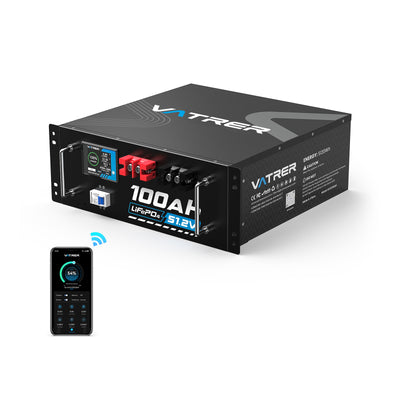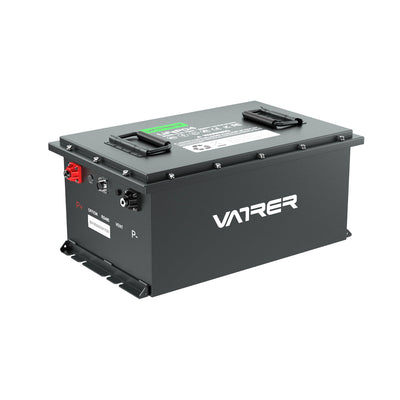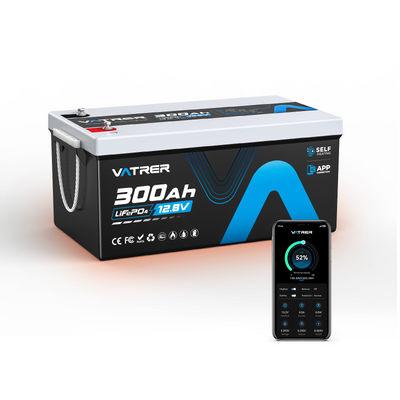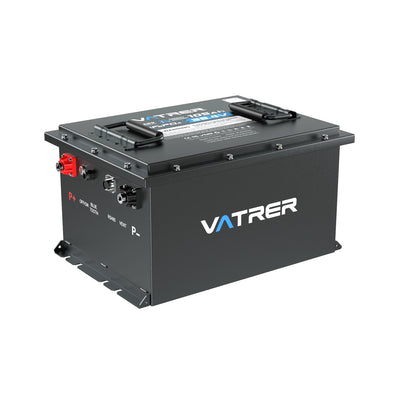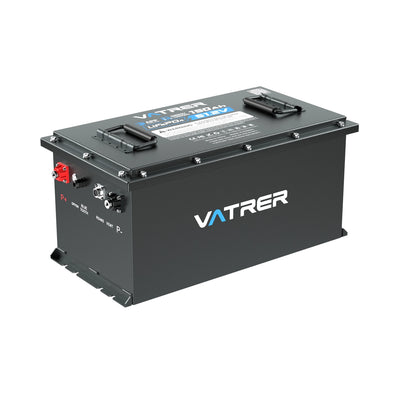
What's The Difference Between 48V And 51.2V Golf Cart Batteries
Picture taking your golf cart farther, with smoother acceleration and fewer headaches along the way. Deciding between traditional 48V golf cart batteries and modern 51.2V golf cart batteries is a key step in getting there. These two voltage platforms power your cart in different ways, influencing speed, driving range and ongoing maintenance costs.
Whether you only use your cart on weekends or rely on it daily for resort shuttles or getting around the community, understanding how 48V vs 51.2V batteries compare helps you get better value from your cart. In this guide, we’ll walk through their main characteristics, look at costs and help you decide which setup fits your situation.

Exploring 48V vs 51.2V Golf Cart Batteries: Key Features
To really understand the 48V vs 51.2V discussion, it helps to look at how each battery system is built and how it works in a golf cart.
48V Golf Cart Batteries
48V golf cart batteries are the long-standing standard, especially in older carts or more cost-conscious models. They usually rely on lead-acid or Absorbed Glass Mat (AGM) batteries wired together to deliver a nominal 48V system voltage.
- Configuration: Typically six 8V or eight 6V batteries connected in series, operating roughly between 42V and 50V over a charge and discharge cycle. A typical bank provides about 100–150Ah of capacity.
- Chemistry: Lead-acid or AGM, which are relatively inexpensive but less efficient in day-to-day use.
- Applications: Suited to short-distance driving on level golf courses or neighbourhood routes with mild inclines.
- Availability: Easy to find almost anywhere, with replacement batteries and parts stocked for most popular cart models.
For basic transportation, these batteries get the job done, but they do need frequent maintenance and generally do not last as long as newer options.
51.2V Golf Cart Batteries
51.2V golf cart batteries use lithium iron phosphate (LiFePO4) technology and are becoming more common because of their performance, convenience and long service life.
- Configuration: Usually built from sixteen 3.2V LiFePO4 cells or four 12.8V lithium modules in series, operating in the 48V–54V range. A 100Ah pack stores about 5,120Wh of energy.
- Chemistry: LiFePO4 delivers higher energy density, good thermal stability and smart capabilities such as Bluetooth monitoring for real-time data. A built-in Battery Management System (BMS) manages charging and protects against over-discharge and other faults.
- Applications: Well suited for resort fleets, carts used on hilly routes or longer daily travel where consistent power is important.
- Scalability: Compact form factors free up space and make it practical to run packs in parallel when extra capacity is required.
Vatrer golf cart batteries help lower long-term maintenance expenses while improving acceleration and range. They are a strong fit for major brands such as Yamaha, Club Car and EZGO.
Comparing 48V vs 51.2V Golf Cart Batteries
Next, let’s compare 48V golf cart batteries and 51.2V golf cart batteries across several important factors. The table below outlines the main differences, followed by a deeper explanation. This will give you a more rounded view of how the two systems differ.
| Feature | 48V Batteries (Lead-Acid/AGM) | 51.2V Batteries (LiFePO4) |
|---|---|---|
| Power Output | Sufficient for everyday, light-duty use | Roughly 10–15% more torque, stronger acceleration |
| Efficiency | About 80–85% efficient | Roughly 92–98% efficient |
| Weight | Heavier (~240–280 lbs for 100–150Ah) | Much lighter (~80–100 lbs for 100Ah) |
| Charging Time | Around 8–10 hours | Roughly 2–6 hours |
| Lifespan | Approx. 2–5 years (500–1,000 cycles) | Approx. 8–10+ years (4,000+ cycles) |
| Maintenance | Needs routine checks and service | Essentially maintenance-free |
| Safety | Subject to corrosion, sulfation and spills | Safer chemistry with BMS protection |
Power Output and Acceleration
Standard 48V golf cart batteries provide enough power for casual driving on flat ground, but you may notice reduced punch as the charge level drops. 51.2V golf cart batteries can deliver roughly 10–15% higher torque, helping carts reach speeds up to about 25 mph (compared to roughly 20 mph with typical 48V setups) and climb hills more confidently, even with several passengers or gear on board.
Efficiency and Range
Efficiency plays a major role in how far you can drive on a single charge. With 48V golf cart batteries running at about 80–85% efficiency, you can usually expect around 20–25 miles per charge on level ground and roughly 15–20 miles in more hilly areas. 51.2V golf cart batteries, operating at roughly 92–98% efficiency, can extend this to about 30–40 miles on flat courses and around 25–30 miles on terrain with more elevation changes, especially with a 51.2V 100Ah battery offering 5,120Wh of capacity. For 18–36-hole rounds or mixed road conditions, this extra range is a clear advantage.
Weight and Handling
A 100–150Ah 48V golf cart battery bank weighing 240–280 lbs adds significant mass to the cart, affecting handling and putting more strain on suspension, brakes and tires. In contrast, 51.2V golf cart batteries—such as Vatrer’s 100Ah model at roughly 99 lbs—can be 60–70% lighter. This reduction improves steering response, braking and overall ride quality, and it can help key components last longer.
Charging Dynamics
With 48V golf cart batteries, an 8–10 hour charging window is common, which can be limiting if the cart is used multiple times a day. 51.2V golf cart batteries can be recharged in roughly 2–6 hours when paired with a proper lithium-specific charger. For example, Vatrer’s 58.4V 20A charger can bring a 100Ah pack from empty to full in about 2 hours, helping fleets and busy users reduce downtime.
Lifespan and Maintenance
48V golf cart batteries generally last about 2–5 years or around 500–1,000 charge cycles, assuming proper maintenance. They require regular watering (for flooded lead-acid), periodic cleaning of terminals and inspection to prevent damage. 51.2V golf cart batteries can typically run for 8–10 years or more (4,000+ cycles), with no water top-ups and no acid spills to manage. This eliminates issues such as sulfation and heavy corrosion when they are used within their specified limits.
Safety Features
Lead-acid-based 48V golf cart batteries can suffer from corrosion, gas release and sulfation if charging and maintenance are neglected. 51.2V golf cart batteries use LiFePO4 chemistry, which is more thermally stable and less prone to thermal runaway. Vatrer’s packs integrate a BMS that guards against overcurrent, short circuits and low-temperature charging, automatically stopping charging below 32°F to help protect the cells and extend service life.
Environmental Impact
From an environmental perspective, 51.2V golf cart batteries have an advantage because they last longer and can reduce waste over time, with fewer packs heading to recycling and landfill—potentially cutting disposal volume by up to 50% over a decade. Conventional 48V golf cart batteries rely on lead-based chemistries and need more frequent replacement, which requires careful recycling and handling to manage environmental risk.
Cost Breakdown: 48V vs 51.2V Golf Cart Batteries
Price is often the deciding factor when choosing between 48V golf cart batteries and 51.2V golf cart batteries. Here is how the numbers generally compare.
Upfront Cost
A 100–150Ah 48V golf cart battery set usually runs in the $800–$1,200 range, which makes it attractive for tighter budgets. A 100Ah 51.2V golf cart battery typically costs between $1,200 and $2,500, reflecting the more advanced technology and longer lifespan.
Long-Term Value
With 48V golf cart batteries, you need to budget for ongoing maintenance (like topping up water in flooded types) and replacement every few years. Over time, those costs add up. 51.2V golf cart batteries require almost no routine maintenance and, thanks to their 8–10+ year life, can save roughly $500–$1,000 or more over a 10-year period. Manufacturers such as Vatrer Battery combine competitive pricing with advanced BMS functions, including Bluetooth connectivity and smart low-temperature protection, to support long-term reliability.
Warranty and Support
Most 48V golf cart batteries come with warranties in the 1–2 year range. 51.2V golf cart batteries often include longer coverage, frequently between 5 and 10 years, reflecting their durability and extended cycle life. Working with a reputable supplier like Vatrer Battery gives you access to dependable after-sales support and features like Bluetooth monitoring that simplify day-to-day use.
Can You Convert from 48V to 51.2V Lithium Batteries?
Switching from 48V golf cart batteries to 51.2V golf cart batteries is a practical way to upgrade performance and range. Here are some key points:
- Feasibility: Many newer golf carts from brands such as Club Car and EZ-GO are designed with controllers that accept the 48V–54V operating window of 51.2V lithium batteries, which helps improve efficiency and distance per charge.
- Compatibility: Confirm that your controller is rated for 48V–54V operation and pair the pack with a lithium-specific 58.4V charger (typically $100–$300). Some older units may require minor wiring changes or controller upgrades ($50–$200). Choosing a Vatrer golf cart battery kit can simplify this, as the kit includes a matched charger and components designed to work together.
- Battery Management System (BMS): The integrated BMS found in Vatrer lithium batteries manages charge and discharge safely, helping protect both the cart’s electronics and the battery pack.
- Installation Tips
- Use components recommended by the battery manufacturer, such as Vatrer-branded chargers, to maintain compatibility and warranty coverage.
- Mount the battery securely and ensure there is adequate ventilation around the pack to help with heat dissipation.
- Review your golf cart’s manual or contact Vatrer for guidance on your specific model. For more complex conversions, professional installation is a good option.
Which Is Right for You: 48V or 51.2V Golf Cart Batteries?
Your choice between 48V golf cart batteries and 51.2V golf cart batteries will depend on how you use your cart and how much you want to invest upfront.
Choose 48V If
- You prefer a lower initial cost ($800–$1,200) and mainly use the cart occasionally—for example, weekend rounds of golf on relatively flat courses with light loads.
- Your cart is an older model designed around lead-acid technology, and you want to keep the setup close to original specifications.
Choose 51.2V If
- You are looking for stronger performance, longer range and a maintenance-free setup for more intensive use, such as resort operations or community carts carrying several passengers over hills.
- You value quick charging and smart features like app-based monitoring, as delivered by Vatrer’s 51.2V golf cart batteries.
You can also use the following common usage scenarios as a reference when deciding:
- Casual Use: A 48V system will generally be adequate for short drives around the golf course with one or two riders.
- Demanding Use: A 51.2V system is better suited to long routes, steeper terrain and heavier payloads, such as community shuttle carts.
- Eco-Conscious Choice: 51.2V golf cart batteries help lower environmental impact through longer life and recyclable materials, reducing waste going to landfill by up to roughly 50% over a decade.
Conclusion: 48V vs 51.2V Golf Cart Batteries Which Is Best?
When weighing 48V vs 51.2V golf cart batteries, start with your priorities. 48V golf cart batteries are more affordable at the outset and still dependable for light, occasional use, but they need ongoing maintenance and more frequent replacement. 51.2V golf cart batteries deliver stronger power, up to roughly 30% more driving range and more than ten years of largely maintenance-free operation, which can save $500–$1,000 or more over the long term. For users who want the best overall performance, Vatrer Batteries provides 51.2V golf cart batteries with smart monitoring and solid technical support, well suited to today’s demands. Confirm that your cart’s electronics are compatible and then explore Vatrer’s range to find a setup that keeps your cart running smoothly.
FAQs
How do I know if my golf cart is compatible with a 51.2V lithium battery upgrade?
- Start by checking your golf cart’s owner’s manual or controller label to confirm the acceptable input voltage range, which for many newer models such as Club Car or EZ-GO is often around 48V–60V.
- Most 48V carts can safely operate within the 48V–54V window used by 51.2V golf cart batteries, but some older carts may need a controller replacement or reprogramming ($200–$500).
- Make sure your charger is suitable for lithium and provides the correct 58.4V output for LiFePO4 packs.
- When in doubt, contact the cart manufacturer or a supplier like Vatrer for recommendations tailored to your specific model.
For a smoother conversion, Vatrer’s 51.2V golf cart battery kits are supplied with compatible chargers and accessories, which helps streamline installation and setup.
What are the risks of not maintaining 48V lead-acid batteries properly?
Skipping regular maintenance on 48V golf cart batteries based on lead-acid chemistry can significantly affect performance, operating life and safety.
If water levels are not topped up in flooded batteries, plates may be exposed and damaged, potentially cutting the service life down to 1–2 years.
Corrosion on terminals increases resistance, which can cause power loss, overheating and, in severe cases, electrical issues.
Leaving batteries discharged can lead to sulfation, where crystals form on the plates and permanently reduce capacity. To minimize these risks, check electrolyte levels monthly (using distilled water), keep terminals clean with a mild baking soda solution and store batteries fully charged. Moving to 51.2V golf cart batteries such as Vatrer’s LiFePO4 line removes most of these maintenance concerns.
Can I mix 48V lead-acid and 51.2V lithium batteries in my golf cart?
Combining 48V golf cart batteries (lead-acid) with 51.2V golf cart batteries (lithium) in the same system is strongly discouraged.
The two chemistries have different voltage curves (about 42V–50V for lead-acid vs. 48V–54V for lithium) and distinct charging requirements. Mixing them can lead to uneven charging, premature wear, and possible damage to the pack and controller. Lead-acid batteries also tend to discharge faster, which can imbalance the system further.
If you are upgrading to lithium, replace the entire 48V bank with a matched 51.2V golf cart battery set and pair it with an appropriate lithium-specific charger.
How does temperature affect 48V vs 51.2V golf cart batteries?
48V golf cart batteries using lead-acid chemistry tend to struggle in temperature extremes. At temperatures below about 32°F, their usable capacity can drop by 20–30%, shortening range, while high heat (above roughly 90°F) speeds up electrolyte loss and may increase maintenance needs.
51.2V golf cart batteries based on LiFePO4 are more stable. They generally maintain over 90% of their capacity in cooler weather and handle heat better due to their stable chemistry.
Vatrer’s batteries include low-temperature charge cut-off functions (disabling charging below 32°F) to help protect the cells. In colder Canadian climates, for example, lead-acid batteries should be stored in a more moderate environment, while lithium packs should be used with an active BMS that manages charging and discharging.
Are there specific golf cart models that work better with 51.2V batteries?
Many current golf cart models from Club Car (such as Precedent and Onward), EZ-GO (RXV, Valor) and Yamaha (Drive2) are well suited to 51.2V golf cart batteries because their controllers are designed for a 48V–60V operating range. Older carts built before the early 2000s may have controllers with tighter limits, sometimes capped near 50V, and may need an upgrade in the $200–$500 range.
Always review your cart’s documentation or nameplate for allowable voltage and controller details. Vatrer's 51.2V golf cart battery kits are designed to integrate cleanly with many of these mainstream models and often include compatible chargers to simplify the process.
How can I maximize the lifespan of a 51.2V lithium battery?
To get the best possible 8–10 year service life from 51.2V golf cart batteries, consider the following practices:
- Use a lithium-appropriate 58.4V charger and avoid charging above the recommended voltage.
- Try not to run the battery to empty; staying above about 20% state of charge reduces stress on the cells.
- When storing the cart for an extended period, leave the battery at roughly 50–70% charge and keep it in a cool, dry location (around 10–25°C / 50–77°F).
- Use the BMS or Bluetooth app, such as Vatrer’s monitoring tool, to periodically check for warnings or abnormal behaviour.
Unlike 48V golf cart batteries, lithium packs do not need water top-ups or routine acid cleanups, but keeping cable connections tight and free of corrosion helps maintain efficiency.
Can I use 51.2V batteries for non-golf cart applications, like solar storage?
Yes, 51.2V golf cart batteries based on LiFePO4 are suitable for many other DC power systems, including solar energy storage, RV house banks and some marine applications. Their high energy density, flat discharge curve and integrated BMS make them flexible in these roles, provided your inverter and charge controller support 48V-class lithium banks.
Traditional 48V golf cart batteries using lead-acid chemistry can also be used in such systems, but their lower efficiency and maintenance requirements make them less convenient. Vatrer’s 51.2V batteries are built with multi-purpose use in mind and offer Bluetooth monitoring that helps with system integration and troubleshooting.
Share


































